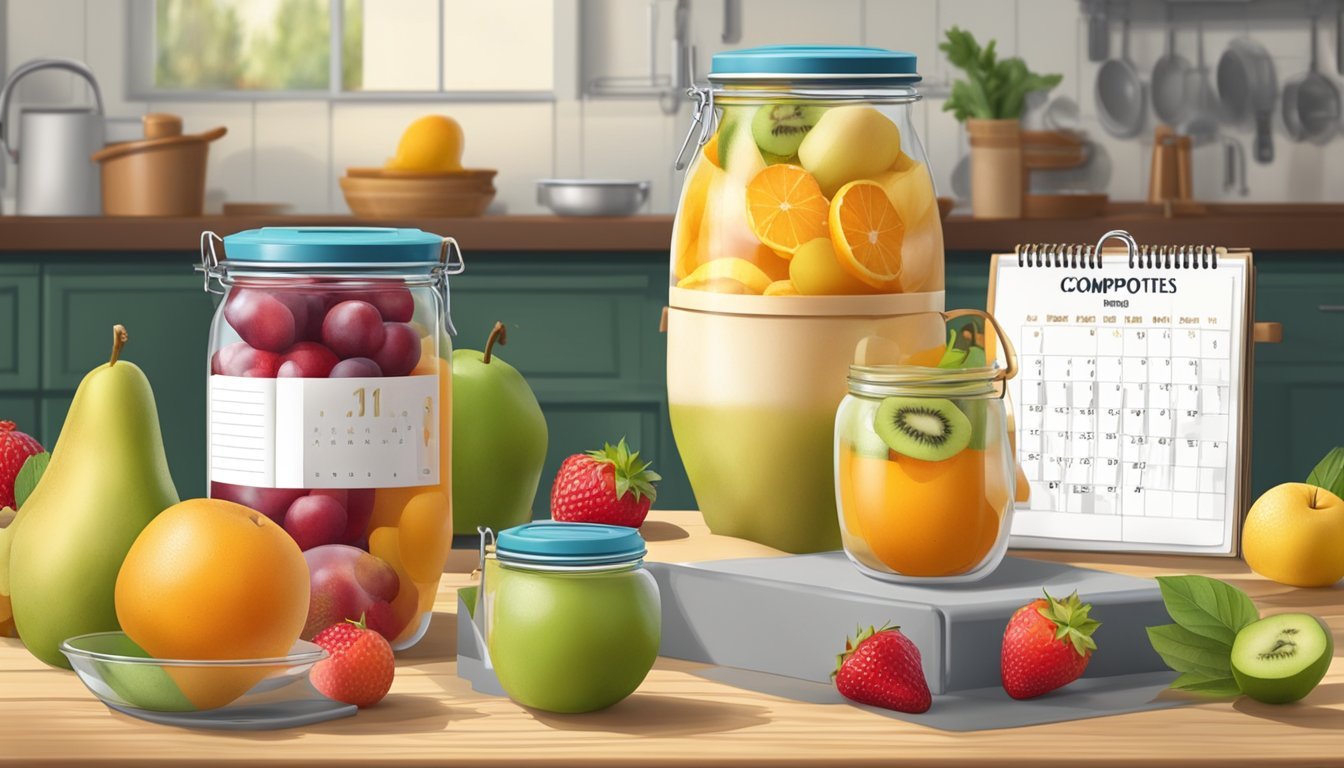How Long Do Freshly Prepared Fruit Compotes Last?
Shelf Life Explained
Fresh fruit (What wine goes well with fruit?) compotes provide a delightful way to enjoy the essence of fruit flavors in a concentrated and versatile form. Made by simmering fruits (What wine goes well with fruits?) with sweeteners, these mixtures are often a staple in desserts and breakfast dishes. When it comes to longevity, freshly prepared fruit compotes have a finite shelf life which is primarily influenced by their acidity, sugar content, and storage conditions. Typically, the high sugar concentration provides a preservative effect, while the acidity can inhibit microbial growth, factors that contribute to the preservation of the compote.
The storage method plays a critical role in extending the freshness of fruit compotes. Refrigeration is essential for maintaining quality over time. When stored properly in an airtight container, a fruit compote can last up to two weeks in the refrigerator. To further extend its shelf life, it may be frozen where it can last several months. However, it's important to note that the texture and flavor profile of the compote can change after freezing and thawing.
Consumers need to be mindful of signs of spoilage such as mold, an off smell, or a change in texture. These indicators suggest that the compote should no longer be consumed. For the best experience with homemade fruit compote, it is advisable to enjoy it while it's fresh and to be attentive to storage practices and spoilage cues.
Understanding Fruit Compotes
A fruit compote is a simple yet versatile dish that can elevate various forms of desserts and breakfasts. By gaining insight into its basics, fruit options, and health implications, one can appreciate the value and applications of fruit compotes.
Definition and Basics
Fruit compote is a concoction of fresh or frozen fruit cooked in a sugar syrup with various flavorings. The basic ingredients often include just fruit, sugar, and a liquid—commonly water, fruit juice, or even liquor. Cooking is done over medium heat until the fruit breaks down and the mixture thickens, resulting in a delightful topping or side. Compotes differ from jams or jellies due to their chunkier texture and lighter consistency.
Common Fruit Choices
The choice of fruit significantly influences the flavor profile and texture of the compote. Berries, such as strawberries and blueberries, are popular for their vibrant flavors and ease of cooking. Stone fruits like peaches also make for a thicker, heartier compote. Lemon is often added for a tart contrast that balances the sweetness. Here's a table showcasing common fruits used in compotes:
Fruit Type Notes Berries Rich in flavor; cook quickly. Peaches Add body and texture to the compote. Strawberries Sweet and aromatic component. Lemon Provides brightness and acidity.
Health Benefits
Fruit compotes retain most of the nutritional benefits of the fruits used. They are a source of fiber, helping with digestion, and contain vitamins like Vitamin A and Vitamin C, which support the immune system and skin health. While compotes do have added sugars, they can be moderated based on personal dietary preferences. Compotes can contribute some calcium and iron, depending on the fruits selected. However, it’s important to note the calories and be mindful of portions if one is watching their caloric intake.
In terms of nutrition, one can enjoy the proteins from fruits to a lesser extent, but a compote’s nutritive value is more about the vitamins and fiber content. For instance, the Vitamin C in strawberries is preserved even when cooked, albeit slightly reduced, and the iron in peach compotes can be beneficial to one's diet.
Creating Fruit Compotes
Creating fruit compotes is a culinary process that involves simmering fruit with sweeteners and other flavorings to produce a versatile topping or ingredient. Understanding the selection of appropriate ingredients and mastering essential cooking techniques are foundational steps. Incorporating flavor enhancers can elevate the final product.
Selecting Ingredients
The foundation of any fruit compote is, naturally, the fruit itself. Chefs should aim for ripe, seasonal fruits for optimal flavor and sweetness. Common choices include berries, peaches, apples, and pears. Fresh fruit is preferred, but frozen can be used with an increased cooking time.
Sweeteners add depth and balance to the tartness of the fruit. Choices include:
Sugar: The most traditional sweetener that helps in extracting juices from the fruit.
Maple Syrup: Offers a rich, deep flavor and is a natural alternative.
Honey: Brings a floral sweetness and can complement certain fruits like berries.
Essential Cooking Techniques
Compote cooking starts with combining the fruit with the chosen sweetener in a saucepan. A dash of salt can enhance the overall flavor profile. Then:
Bring the mixture to a boil over medium-high heat, stirring occasionally.
Once boiling, reduce the heat to simmer.
Cook until the fruit softens and the liquid reduces to a desired consistency.
The use of a saucepan is crucial to evenly distribute the heat.
Flavor Enhancers
To elevate the compote beyond its basic taste profile, culinary artists often integrate various flavor enhancers:
Spices such as cinnamon or vanilla can add warmth and complexity.
A dash of lemon juice can brighten the compote and balance sweetness.
Herbs like basil or ginger introduce a unique twist, offering fresh or spicy notes respectively.
It is best to add these enhancers towards the end of cooking to preserve their delicate flavors.
Consistency and Texture
The consistency and texture of a fruit compote are crucial for its desired application, whether it's serving as a topping for pancakes or a spread for toast. Achieving the ideal thickness and maintaining a soft yet substantial texture ensure a pleasurable eating experience.
Achieving Desired Thickness
For a fruit compote to be versatile, it should be thick enough to cling to a spoon yet not as solid as jam. Preparing the compote involves:
Heating Fruit: The fruit is cooked until it breaks down, thickening naturally from the pectin present within the fruit.
Sweetener: Depending on taste, a sweetener ranges from a sprinkle to generous amounts. It helps the compote to thicken by drawing out the fruit's natural juices.
Cornstarch: Select recipes include cornstarch mixed with cold water, integrated into the simmering fruit for additional thickening.
Flour: A gluten-free alternative, such as a slurry of gluten-free flour mixed with water, can also be used to thicken the compote without altering its flavor.
Adjusting for Special Diets
One must consider specific dietary needs without compromising on texture:
Gluten-Free Needs: Thickening agents such as cornstarch or gluten-free flours are ideal for maintaining a gluten-free consistency.
Sweetness for Diabetics: Compotes can be sweetened with low-glycemic-index sweeteners, retaining the simple fruit flavor while being considerate of blood sugar control.
Reduced Sugar: For those monitoring sugar intake, using ripe, naturally sweet fruit can minimize or eliminate the need for added sweetener.
Serving and Usage
Freshly prepared fruit compotes offer a versatile and flavorful addition to a wide range of dishes. They can serve as the perfect complement to both sweet and savory items, elevating the taste experience.
Pairing with Foods
The vibrant taste of fruit compote makes it an ideal pairing with various foods. For a classic combination, one might spoon it over ice cream for a sweet and fruity treat. It also pairs beautifully with dessert dishes, adding a burst of flavor and color. Here are some specific pairings:
Cream: Dollop on top of whipped cream for a fresh taste.
Toast: Spread over buttered toast as a jam substitute.
Cheese: Serve alongside cheese for a sophisticated appetizer.
Incorporating into Meals
Incorporating fruit compote into meals can transform ordinary dishes into something special. It can be used as a topping or a mix-in. Here's how one can integrate compote into various meals:
Breakfast: Add a spoonful to oatmeal or overnight oats for added sweetness.
Pancakes, Waffles, & French Toast: Use it as a topping instead of syrup.
Baked Goods: Fold into muffin or cake batters for fruity bursts.
The addition of fruit compote to everyday dishes enhances flavors and brings a new twist to traditional recipes.
Storage and Preservation
Proper storage and preservation are crucial for maintaining the quality and extending the lifespan of freshly prepared fruit compotes. These guidelines ensure that the compote remains safe to consume and retains its flavor.
Optimal Storage Conditions
For fresh fruit compote to remain at its best, it should be stored in the refrigerator immediately after cooling to room temperature. The ideal storage temperature is at or below 4°C (39°F). It is essential to use airtight containers to protect the compote from absorbing other flavors and odors present in the refrigerator.
Maximizing Shelf Life
To maximize the shelf life of your fruit compote, prompt refrigeration is vital. Typically, a freshly prepared compote can be preserved for up to 2 weeks when stored properly in the refrigerator. To further ensure longevity, one should minimize the number of times the compote is taken out and exposed to air, as this can introduce contaminants and reduce shelf life.
Freezing and Thawing Tips
For longer preservation, freezing fruit compote is an effective method. Store the compote in a freezer-safe bag or container, label it with the freeze date, and it can last for up to 6 months. When ready to use, thaw the compote in the refrigerator overnight. It is not recommended to refreeze the compote after it has been thawed, as this can affect the taste and texture.
Health Considerations
When preparing fruit compotes, it's important to consider their sugar content and potential allergens, particularly for those with specific dietary restrictions. A compote's nutritional value can vary based on the ingredients used, including types of fruit, added sweeteners, and any additional flavorings.
Sugar Content and Alternatives
Fruit compotes traditionally include added sweeteners to enhance flavor. However, this can increase the overall sugar content and caloric intake.
Sugar Alternatives: To reduce sugar content, consider using natural sweeteners like honey or maple syrup.
Sweetener Nutritional Values: These sweeteners also contain calories but may offer different nutritional profiles, including minerals and antioxidants.
It is always beneficial to be mindful of the total amount of sweetener added to manage calories and carbohydrates in one's diet. For a lower-calorie option, sweeteners like stevia or erythritol can be used as they have little to no caloric value.
Allergens and Dietary Restrictions
Fruit compotes can generally be inclusive of many dietary needs, but it is critical to consider all ingredients to ensure they align with individual dietary restrictions.
Gluten-Free: Compotes are naturally gluten-free, as they primarily consist of fruit and sweeteners.
Nutrition and Fat Content: Compotes typically contain negligible amounts of fat, saturated fat, and polyunsaturated fat, unless additional ingredients such as nuts are introduced.
For those sensitive to specific fruits or with allergies, such as citrus allergies, avoiding those fruits is necessary. Always confirm the absence of allergenic substances if the compote is not homemade. Additionally, individuals monitoring their sodium intake should note any added ingredients that may contribute to the overall sodium content.
Recipe Variations and Innovations
In the world of fruit compotes, the possibilities for variations and innovations are vast. This section will navigate through different fruits that can be used, explore a range of flavor combinations, and suggest seasonal ideas to elevate the traditional fruit compote.
Exploring Different Fruits
Using a variety of fruits can significantly change the taste and texture of a compote. Stone fruits such as peaches, plums, and apricots become tender and release their sweet juices when simmered, while berries like blueberries, strawberries, and blackberries offer a more pronounced tartness. Apples and pears are ideal for compotes due to their firm texture, which softens nicely but does not disintegrate. Frozen fruit can be a convenient alternative, ensuring that the desired flavors are available year-round.
Fresh Fruits: Peaches, apples, pears, apricots, plums
Berries: Blackberries, cherries (how long do cherries last?), raspberries, blueberries, strawberries
Frozen Fruit: Generally requires an extra few minutes of cooking to achieve the desired consistency.
Creative Flavor Combinations
A fruit compote isn't just about the fruit—it's about how the ingredients combine to create a unique flavor profile. Introducing additional components such as citrus zest, vanilla, cinnamon, or ginger can transform a simple fruit sauce into a gourmet experience. For example:
Peach Compote: Peaches with a hint of bourbon and vanilla
Blueberry Compote: Blueberries with lemon zest and a sprinkle of nutmeg
Experimenting with different sweeteners like maple syrup, honey, or even a dash of balsamic vinegar can also offer a new twist to the standard recipe.
Seasonal and Festive Ideas
Compotes can be adapted to fit any season or celebration. In autumn, a spiced apple compote with cinnamon, cloves, and star anise is warming and comforting. During the summer months, a berry compote with a mix of strawberries, blueberries, and raspberries celebrates the bounty of the season. Festive variations, such as a cherry compote infused with orange zest and cloves or apricot compote laced with almond extract, can provide a delightful accompaniment to holiday desserts. Even dried fruits like apricots or plums offer a richer, more concentrated flavor and chewy texture, which can be particularly appealing in the colder months.
Autumn: Apple compote with spices
Summer: Mixed berry compote
Festive: Cherry compote with orange zest; Apricot compote with almond extract






